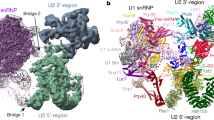Abstract
The mechanism whereby eukaryotic pre-messenger RNAs are polyadenylated is unknown. Most models for polyadenylation invoke cleavage of precursor transcripts at the site of poly(A) addition followed by polymerization of A residues by poly( A) polymerase1–5. Analysis of the sequences surrounding poly(A) addition sites has identified the consensus recognition sequence element AAUAAA as necessary but not sufficient for polyadenylation6–14. A second recognition sequence element CACUG, was observed by Benoit et al.15 to be adjacent to the site of poly(A) addition in several sequenced RNAs. Here, we analyse 61 vertebrate poly(A) addition sequences, define a more extensive recognition sequence for polyadenylation than previously recognized and suggest how the site of poly(A) addition may be chosen. Furthermore, we find that the defined recognition sequence has elements which are complementary to regions within the small nuclear RNA U4, suggesting that U4 small nuclear ribonucleoproteins (snRNPs) may mediate polyadenylation in a fashion similar to the role of U1 snRNPs in splicing. The model invokes hybridization of U4 RNA to AAUAAA recognition elements as related to primary site selection, and hybridization to CAYUG recognition elements as related to cleavage site selection.
This is a preview of subscription content, access via your institution
Access options
Subscribe to this journal
Receive 51 print issues and online access
$199.00 per year
only $3.90 per issue
Buy this article
- Purchase on Springer Link
- Instant access to full article PDF
Prices may be subject to local taxes which are calculated during checkout
Similar content being viewed by others
References
Ford, J. P. & Hsu, T.-T. J. Virol 28, 795–801 (1978).
Lai, C.-J., Dhar, R. & Khoury, G. Cell 14, 971–982 (1978).
Nevins, J. R. & Darnell, J. E. Cell 15, 1477–1493 (1978).
Nevins, J. R., Blanchard, J.-M. & Darnell, J. E. Jr J. molec. Biol. 144, 377–386 (1980).
Hofer, E. & Darnell, J. E. Jr Cell 23, 585–593 (1981).
Proudfoot, N. J. & Brownlee, G. G. Nature 252, 359–362 (1974).
Fitzgerald, M. & Shenk, T. Cell 24, 251–260 (1981).
Hagenbuchle, C., Bovey, R. & Young, R. A. Cell 21, 179–187 (1980).
Jung, A., Sippel, A. E., Grez, M. & Schutz, G., Proc. natn. Acad Sci. U.S.A. 77, 5759–5763 (1980).
Cole, C. N. & Santangelo, G. Molec. cell. Biol. 3, 267–279 (1983).
Reddy, V. B., Ghosh, P. K., Lebowitz, P., Piatek, M. & Weissman, S. J. Virol. 30, 279–296 (1979).
Fiers, W. et al. Nature 273, 113–120 (1980).
Perricaudet, M., Akusjarvi, G., Virtanen, A. & Pettersson, U. Nature 281, 694–696 (1979).
Santangelo, G. M. & Cole, C. N. Molec. cell. Biol. 3, 643–653 (1983).
Benoist, C., O'Hare, K., Breathnach, R. & Chambon, P. Nucleic Acids Res. 8, 127–142 (1980).
Busch, H., Reddy, R., Rothblum, L. & Choi, Y. C. A. Rev. Biochem. 51, 617–654 (1982).
Krol, A. & Branlant, C. Nucleic Acids Res. 9, 2699–2716 (1981).
Branlant, C., Krol, A., Ebel, J.-P., Lazar, E., Haendler, B. & Jacob, M. EMBO J. 1, 1259–1265 (1982).
Liautard, J. P., Sri-Widada, J., Brunel, C. & Jeanteur, P. J. molec. Biol. 162, 623–644 (1982).
Bringmann, P., Rinke, J., Apiel, B., Reuter, R. & Luhrmann, R. EMBO J. 2, 1129–1136 (1983).
Montell, C., Fisher, E. F., Caruthers, M. H. & Berk, A. J. Nature 305, 600–601 (1983).
Lerner, M. R., Boyle, J. A., Mount, S. M., Wolin, S. L. & Steitz, J. A. Nature 283, 220–223 (1980).
Rogers, J. & Wall, R. Proc. natn. Acad. Sci. U.S.A. 77, 1877–1881 (1980).
Wise, J. A. et al. Cell 35, 743–751 (1983).
Tollervey, D., Wise, J. A. & Guthrie, C. Cell 35, 753–762 (1983).
Mount, S. M., Pettersson, I., Hinterberger, M., Karmas, A. & Steitz, J. A. Cell 33, 509–518 (1983).
Chen-Kiang, S., Wolgenmuth, D. J., Hsu, M.-T. & Darnell, J. E. Jr Cell 28, 575–584 (1982).
Manley, J. L. Cell 33, 595–605 (1983).
Moore, C. & Sharp, P. A. Cell (in the press).
Le Moullec, J. M. et al. J. Virol. 48, 127–134 (1983).
Author information
Authors and Affiliations
Rights and permissions
About this article
Cite this article
Berget, S. Are U4 small nuclear ribonucleoproteins involved in polyadenylation?. Nature 309, 179–182 (1984). https://doi.org/10.1038/309179a0
Received:
Accepted:
Issue Date:
DOI: https://doi.org/10.1038/309179a0
This article is cited by
-
A multispecies comparison of the metazoan 3'-processing downstream elements and the CstF-64 RNA recognition motif
BMC Genomics (2006)
-
Isolation and characterization of the glucose-6-phosphate dehydrogenase encoding gene (gsdA) fromAspergillus niger
Molecular and General Genetics MGG (1995)
-
The size heterogeneity of human lysyl oxidase mRNA is due to alternate polyadenylation site and not alternate exon usage
Molecular Biology Reports (1995)
-
Heterologous transformation of Mucor circinelloides with the Phycomyces blakesleeanus leul gene
Current Genetics (1992)
-
SyntheticcryIIIA gene fromBacillus thuringiensis improved for high expression in plants
Transgenic Research (1992)
Comments
By submitting a comment you agree to abide by our Terms and Community Guidelines. If you find something abusive or that does not comply with our terms or guidelines please flag it as inappropriate.



